Marvell - 用于摄像头和车载显示的高效以太网物理层功能研究
Marvell荣获认证的G.hn芯片组助力Netwave打造家庭联网解决方案

源 可 以 马上 开 始 基 于 J E S D 2 0 4 B 的 串 行 接 口的 开 发 工 作 ,
而 设 计 人 员 能 够 灵 活 地 选 择 最 符 合 系 统 功 耗 和 性 能 需 求 的F P GA 和 数 据 转 换 器 。
态 电压范围 。
为 用 户 带 来 极 大 灵活 性
Mi c r o c h i p Te c h n o l o g y I n c . ( 美 国微芯科 技公 司) 宣 布
推 一 款 极 具 灵 活 性 的 交 钥 匙 式 低 功 率 传 感 器 集 线 器 S S C 7 1 0 2 。新 器 件 不 仅 令 传 感 器 融 合 的 实 现 更 为 轻 松 , 还
J ES D2 0 4 B是 高 速 串 行 接 口标 准 , 采用 F P GA 和 模 数 嵌 入 式 控 制 系 统 的人 机 界 面 ( HMI ) 应用, 包 括 工 业 控 制 终 转 换 器 ( ADc ) 以及 数 模 转 换 器 ( DAC) 时, 极 大 地 简 化 了 电 端、 智 能仪 表 、 医疗 产 品 、 网 络 终 端 以 及 数 据 采 集 与 分 析 路 板 设 计 。Al t e r a与 主 要 的 数 据 转 换 器 供 应 商 进 行 了 器
池 寿命 。
Al t e r a F P GA 和 高 速 数 据 转 换 器 的 பைடு நூலகம் 成 。 很 多 应 用 都 使
e络 盟 为 基 于 AR M 的单 板 机 推 出用 于 人 机 交 互 界 面 的触 摸 屏 模 块
e络 盟 为 基 于 ARM 的 单 板 机 ( S B C) 推 出 一 款 全 集 成 嵌入式显 示模块 ( E DM) —— E DM6 0 7 O AR 一0 1 , 即 一 款 可
汽车总线及车载网络技术

4
能够理解MOST总线的原理,熟悉MOST总 线在汽车中的应用
5
能够理解车载以太网的主要技术,熟悉车载 以太网的应用
01 •汽车总线
汽车总线技术的产生与分类
• 1.汽车总线技术的产生
• 请说说为什么要使用总线技术?
汽车总线技术的产生与分类
• 2.汽车总线的分类
• 美国汽车工程师学会(SAE)的汽车网络委员会按照系统的复杂程度、传输流量、传输速度、传输可靠性、 动作响应时间等参量,将汽车数据传输网络划分为A、B、C、D、E五类。
LIN总线
• 2. LIN总线系统的结构
• (1)LIN的网络结构 • LIN总线上的最大电控单元节点数为16个,系统中
两个电控单元节点之间的最大距离为40m。 • LIN总线网络由一个主节点一个或多个从节点组成。
所有节点都包含一个从任务(Slave Task),负责 消息的发送和接收;主节点还包含一个主任务 (Master Task),负责启动LIN总线网络中的通 信。
CAN总线
• CAN网络拓扑可以根据几何图形的形状分为五种类型:总线拓扑、环形拓扑、星型拓扑、网络拓扑和树型 拓扑,这些形状也可以混合形成混合拓扑。因为电动汽车的网络特性可以概括为通信距离短、网络复杂度要 求低、可扩展性要求高、实施可靠性要求高。
星形拓扑
网络拓扑
环形拓扑
树形拓扑
图 6-2 CAN 网络拓扑形式
LIN总线
• (2)LIN的节点结构 • 一个LIN节点主要由微控制器和LIN收发器组成,而微控制器通过UART/SCI接口与LIN收发器连接,几乎所
有微控制器都具备UART/SCI接口,并且LIN收发器(如TJA1020、MC33399等)的RXD、TXD引脚可与微 控制器的RXD、TXD引脚直接连接,无需电平转换。在LIN系统中,加入新节点时,不需要其他从节点作任 何软件或硬件的改动。LIN和CAN一样,传送的信息带有一个标识符,它给出的是这个信息的意义或特征, 而不是这个信息传送的地址。
基于千兆以太网的红外热像仪数据传输
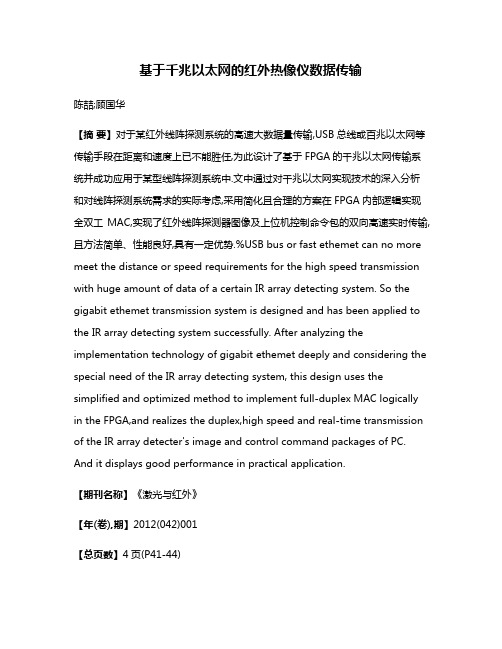
基于千兆以太网的红外热像仪数据传输陈喆;顾国华【摘要】对于某红外线阵探测系统的高速大数据量传输,USB总线或百兆以太网等传输手段在距离和速度上已不能胜任,为此设计了基于FPGA的千兆以太网传输系统并成功应用于某型线阵探测系统中.文中通过对千兆以太网实现技术的深入分析和对线阵探测系统需求的实际考虑,采用简化且合理的方案在FPGA内部逻辑实现全双工MAC,实现了红外线阵探测器图像及上位机控制命令包的双向高速实时传输,且方法简单、性能良好,具有一定优势.%USB bus or fast ethemet can no more meet the distance or speed requirements for the high speed transmission with huge amount of data of a certain IR array detecting system. So the gigabit ethemet transmission system is designed and has been applied to the IR array detecting system successfully. After analyzing the implementation technology of gigabit ethemet deeply and considering the special need of the IR array detecting system, this design uses the simplified and optimized method to implement full-duplex MAC logically in the FPGA,and realizes the duplex,high speed and real-time transmission of the IR array detecter's image and control command packages of PC. And it displays good performance in practical application.【期刊名称】《激光与红外》【年(卷),期】2012(042)001【总页数】4页(P41-44)【关键词】红外线阵探测系统;FPGA;千兆以太网;全双工MAC;高速实时传输【作者】陈喆;顾国华【作者单位】南京理工大学近程高速目标探测技术国防重点学科实验室,江苏南京210094;南京理工大学近程高速目标探测技术国防重点学科实验室,江苏南京210094【正文语种】中文【中图分类】TP393.111 引言在某型号红外线阵探测系统中存在成像和搜索两种工作模式,其中成像的图像大小为480×800,帧频为50 f/s,像素位宽为16位,所需传输带宽为38.4mB/s,而搜索模式下带宽要求会更高,一般的数据传输手段如百兆以太网等已远不能满足其带宽要求,对于探测系统在应用灵活性、稳定性和传输距离等方面的要求,USB 等速度较高的传输方法也不能满足。
Teledyne Lecroy - 汽车以太网一致性与信号完整性分析
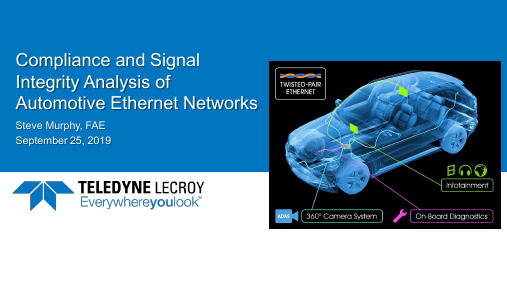
▪ Oscilloscope and fixture setup ▪ Software analysis including: Eye Diagrams, eye measurements, equalization ▪ TDR
▪
12
UNH IOL - Tests and Test Modes: 100BASE-T1 and 1000BASE-T1
▪
13
Test Modes – PHY Register Control Examples – PHY Vendor Utilities
▪ Broadcom
▪ Fibercode – FC601
▪ Oscilloscope with Spectral Analysis capability or Spectrum Analyzer
▪ Disturbing Sine Wave Generator
(used for test mode 4 only)
▪ 5.4 Vpk-pk at 11.11 MHz ▪ 2 BNC cables ▪ 2 BNC-SMA adapters
OABR (OPEN Alliance BroadR-Reach)
100Base-T1 1000Base-T1
RTPGE (Reduced Twisted
Pair Gigabit Ethernet)
Automotive Ethernet
Physical Layer Compliance Testing 100/1000 Base-T1
Where is Electrical Compliance Testing Defined?
Marvell终寻新东家ASR 锐迪科前CEO或成立“复仇者联盟”

Marvell终寻新东家ASR 锐迪科前CEO或成立“复仇者联盟”作者:王欣来源:《通信产业报》2017年第21期整合、收购向来是通信圈的常事。
近日,曾经辉煌一时的Marvell(美满电子科技)也找到了新东家。
有消息称,ASR-翱捷科技(上海)有限公司已经完成了对Marvell的MBU(移动通信部门)收购,这一部门正是Marvell一直想卖掉的做手机基带芯片的部门。
辉煌消散Marvell是1995年由周秀文与妻子戴伟丽联合创建的,提供全套宽带通信和存储解决方案。
据了解,在2010年,Marvell为中国市场开发了TD-SCDMA单芯片PXA 920,一度占据90%市场份额。
2013年底,中国4G牌照发放之时,Marvell更是抢在联发科、展讯之前推出了首款适用于千元智能手机的4G芯片,抢占了还在发展初期的4G市场。
根据Marvell过往财报显示,2014年第一季度和第二季度,Marvell手机芯片收入分别为3.15亿美元和2.89亿美元。
截至2014年9月,Marvell的4G芯片在中国市场份额高达30%,其4G芯片出货量位居全球第二,仅次于高通,领先于竞争对手联发科、展讯。
在2014年底中国移动合作伙伴大会上,中国移动总裁李跃表示,Marvell在4G发展中立下了汗马功劳。
但随着高通4G芯片出货量趋于稳定,联发科、展讯4G芯片逐步成熟,在2014年第三季度到2015年第一季度,Marvell的销售收入不断下滑,市场份额也不断萎缩。
2015年8月,Marvell就在公开寻找买家出售其无线芯片业务,那时中国企业联芯科技就有意收购Marvell,但是传言由于Marvell“身价太高”,最终没能谈成。
持续遭遇寒冬的Marvell,在2015年10月,在中国区裁员近800人。
在2016年4月,Marvell宣布,公司CEO周秀文和总裁戴伟丽已离职,公司成立了临时管理部门,并公开寻找买家。
这也意味着曾经的巨人真的倒下了。
车载以太网测试之实锤-物理层PMA测试实践
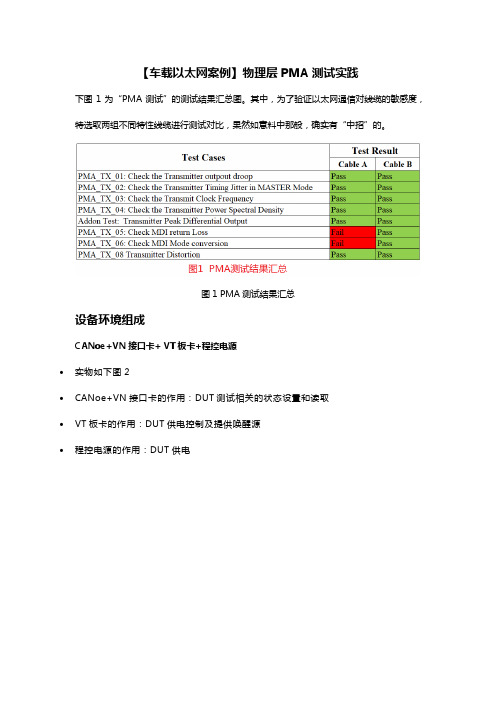
【车载以太网案例】物理层PMA测试实践下图1为“PMA测试”的测试结果汇总图。
其中,为了验证以太网通信对线缆的敏感度,特选取两组不同特性线缆进行测试对比,果然如意料中那般,确实有“中招”的。
图1 PMA测试结果汇总设备环境组成CANoe+VN接口卡+ VT板卡+程控电源•实物如下图2•CANoe+VN接口卡的作用:DUT测试相关的状态设置和读取•VT板卡的作用:DUT供电控制及提供唤醒源•程控电源的作用:DUT供电示波器+信号发生器+测试软件R&S ScopeSuite•型号:RTO2014,实物如下图3•作用:Transmitter outpout droop、Transmitter timing jitter in MASTER mode、Transmit clock frequency、Transmitter Power Spectral Density、Peak Differential Output、Transmitter Distortion测试图3 以太网示波器RTO2014网络分析仪+软件•型号:ZND,实物如下图4•作用:MDI Return loss、MDI Mode Conversion Loss测试图4 网络分析仪ZND 测试夹具•型号:ZF2,实物如下图5•作用:接口转换、环境配置图5 测试夹具RT-ZF2 秘密武器型号:定制作用:与网络分析仪配合使用,满足对应测试被测对象组成DUT:多通道以太网节点实物如下图6:图6 被测以太网节点专用线束配置调试接口测试过程类别一:基于示波器测试内容•Check the Transmitter outpout droop•Check the Transmitter timing jitter in MASTER mode •Check the Transmit clock frequency•Check the Transmitter Power Spectral Density (PSD)•Check the Peak Differential Output•Check the Transmitter Distortion测试基本流程•测试准备:连接DUT、夹具、示波器探头、信号发生器探头•测试执行:控制器上电➔唤醒DUT➔PHY配置➔操作示波器软件(如下图7)➔获得测试数据和报告图7 测试软件类别二:基于网络分析仪测试内容•Check MDI Return Loss•Check MDI Mode Conversion Loss测试基本流程•测试准备:连接DUT、夹具、网分探头及定制模块•测试执行:校准➔控制器上电➔唤醒DUT➔PHY配置➔操作网络分析软件➔获得测试报告测试结果上述测试内容的结果参考如下图8~13:图8 Transmitter outpout droop图9 Transmitter Timing Jitter in MASTER Mode And Transmit Clock Frequency图10 Transmitter Power Spectral Density And Peak Differential Output Voltage图11 Transmitter Distortion图12:两种线束的MDI Return Loss图13:两种线束的MDI Mode Conversion Loss。
Marvell发布新款Link Street交换机支持节能以太网和语音视频桥接

Marvell发布新款Link Street交换机支持节能以太网和语音视频桥接全球整合式芯片解决方案的领导者美满电子科技(Marvell,Nasdaq交易代码:MRVL)日前发布三款Link Street®以太网系列新品,为低成本、能耗敏感的应用提供了快速以太网和千兆以太网解决方案。
Marvell® 88E6352、88E6250和88E6220均集成了物理层(PHY)芯片,支持802.3az节能以太网(Energy Efficient Ethernet,EEE)标准,以及其他多个先进的功能,包括局域网唤醒(Wake-on-LAN,WoL)、集成的开机热启动(Power-On Reset)控制器和电源监视器。
此外,新设备还支持IEEE 802.1新的语音视频桥接(AVB)标准,可以无缝交付延时敏感的多媒体流量,在容易配置的以太网中实现消费级和专业级的语音视频应用。
它们还支持IEEE 1588v2 PTP精确时钟协议(Precision Time Protocol)标准,实现以太网上节点之间1毫秒以内的时钟同步。
这一新的系列产品主要面向包括无线路由器、网关和企业网络接入在内的公共云和私有云接入市场,为它们提供高成本效率和能源效率解决方案,同时扩展以太网的能力,满足云内部应用中以媒体为中心的应用需求,例如:机顶盒、数字录像机、音频/视频接收器等等。
新闻要点•用AVB创建面向连接的以太网,为多媒体内容提供时间和带宽保证•高能效和高性能对实现成本效率高的云服务、对云网络规模的扩大至关重要•封装中集成了电压调节,节省空间,优化成本,降低了系统成本•正在生产设备样机,预计2011年第三季度实现量产产品亮点88E6352 •7端口千兆以太网交换机,具有5个集成的三速PHY、GMII、RGMII和Serdes/SGMII接口•集成的PHY,支持802.3az节能以太网(Energy Efficient Ethernet),当网络空闲时可以降低能耗70%以上•支持最新的AVB标准•256个条目TCAM,提供多达96字节深度的包检测•支持IEEE 1588v2工业以太网应用•低成本128引脚QFP(14x14毫米)封装88E6250和88E6220 •88E6250是一个7端口的快速以太网交换机,具有5个有集成的快速以太网 PHY和两个RMII(或一个MII/RGMII)接口•88E6220是一个4端口的快速以太网交换机,具有2个有集成的快速以太网PHY和两个MII/RMII接口•集成的PHY,支持802.3az 节能以太网(Energy Efficient Ethernet),当网络空闲时可以降低能耗50%以上•支持最新的AVB标准•支持IEEE 1588v2工业以太网应用•64引脚QFN(9x9毫米)封装,是当前市场上体积最小的7端口快速以太网交换机引言•Marvell 公司市场总监Ali Khan说,“Marvell新推出的Link Street SOHO交换机是一个超级有竞争力的产品系列,它具备了家庭云最关注的三大优势:成本、易用性和灵活性。
Marvell_千兆以太网PHY芯片_88E1340S

NOTE: Auto-Media(自动媒体), 即芯片可以自动识别出媒体为电口或光口
关于芯片内部寄存器的介绍. 请参考 Marvell 88E1340S/1340/1322 备支持三种速度下的 Auto-MDI/MDIX ,使安装更加方便降低安装成本. 支持用于诊断/测试的还回模式. 在 15×15 毫米 196 针 TFBGA 封装.
88E1340S/88E1340 操作模式: 4 个 SGMII 接电口的端口 4 个 QSGMII 接电口的端口 4 个 QSGMII 接 SGMII 的端口 4 个 QSGMII 接 电口/光口 自动媒体的端口 2 个 SGMII 接两个电口/光口 自动媒体的端口
Marvell PHY 88E1340S 韩大卫@吉林师范大学
88E1340S 千兆以太网 PHY(物理层)芯片. 88E1340S/88E1340/ 支持 10/100/1000 QSGMII(Quad-Serial Gigabit Media Independent Interface)接口. 支持 QSGMII 接口用于直连 MAC 芯片或 SWITCH 芯片. QSGMII 接口将 4 个速率为 1.25Gbps 的 SGMII 接口结合为一个速率为 5 Gbps 的差分信号. QSGMII 接口减少了接 MAC 接口的引脚数量, 降低了整体的功耗. QSGMII MAC 接口可以被当作铜轴网线(电口)或光纤(光口)使用. 88E1340S/88E1340 也可支持 SGMII 接口在接 MAC 的接口上, 用于一个 SGMII 接口接电口的应用. 88E1322 支持两个 SGMII 端口 接两个电口/光口 自动媒体的应用 88E1340S/40/22 集成了 MDI 接口的终端电阻器和电容器到 PHY 中.该电阻器的集成通过减少外部元件 的数量,简化了电路板布局和电路板的成本降低. 全新的 Marvell®校准电阻器计划将达到并超过 IEEE 80 2.3 回波损耗规格的精度要求。 88E1340S/40/22 完全兼容 IEEE 802.3 标准. 包括 PMD, PMA, PCS 子层. 执行 PAM3, 8B/10B,4B/5B, MLT-3, NRZI , Manchester 编码/解码, 数字时钟恢复, 数字自适应均衡器的接收 器的数据路径, 线发射器的脉冲整形的数字滤波, 自动协商等管理功能.
Symwave全球首款USB 3.0物理层解决方案

Symwave全球首款USB 3.0物理层解决方案个人计算机、消费及移动装置的高效能模拟/混合信号半导体解决方案供应商Symwave(芯微技术)发布全球首款符合USB3.0规范的物理层(PHY)解决方案。
并首次在加州圣荷西举行的超高速USB开发会议(SuperSpeed USB Developer Conference)中,以超高速5Gbps进行现场展示,较目前速度最快的USB装置速度提升了十倍。
在此会议中,也同时首次公开发行最新的1.0版规范。
SuperSpeed USB可与目前已出货超过100亿个USB设备向下兼容,不但能提升高达10倍的传输速度,同时还能提高功耗效能。
这一USB3.0推广组织(contributor group)由超过200家的公司组成,包括消费电子、移动设备、存储、与计算机等各领域的领导品牌厂商。
拥有强大的业界支持力量,SuperSpeed USB在未来几年将能成为最广泛使用的高速连接技术。
Symwave的Quasar PHY将锁定快速成长的“sync-and-go”(同步转发)应用,例如外部存储设备、便携式电话、媒体播放器、HD摄影机以及其它需要高速数据传输的应用。
在Symwave对客户、策略伙伴与媒体所进行的现场展示中,展现运用Symwave专利知识产权与高速混合信号设计方法所能实现的Quasar低功耗与优异抖动(jitter)效能。
In-Stat资深分析师Brian O’Rourke指出,“仅在2023年,全球就出货了超过26亿个USB设备,由此可以想见USB3.0的庞大市场机会,并将大幅取代其它所有的有线互连技术。
根据我们今年四月所发布的有线USB 2023:SuperSpeed时代即将来临(Wired USB 2023: SuperSpeed is Coming)报告中指出,从2023至2023年,USB3.0市场的年复合增长率将超过100%,到2023年将达到超过5亿个设备的出货量。
基于Marvell芯片的千兆光纤以太网交换机

基于Marvell芯片的千兆光纤以太网交换机魏然;龚焕星;苏小柳【摘要】为确保通信设备的以太网数据业务在恶劣使用环境下保持稳定和畅通,设计了一种基于Marvell芯片的千兆光纤以太网交换机,描述了交换机的整体架构和各功能模块的电路设计,并对其试验环境和测试结果进行了说明.【期刊名称】《光通信技术》【年(卷),期】2016(040)004【总页数】2页(P15-16)【关键词】Marvell;千兆以太网;以太网交换机【作者】魏然;龚焕星;苏小柳【作者单位】中国电子科技集团公司第三十四研究所,广西桂林541004;中国电子科技集团公司第三十四研究所,广西桂林541004;中国电子科技集团公司第三十四研究所,广西桂林541004【正文语种】中文【中图分类】TN915近年来,以太网已成为人们生活中不可或缺的一部分,以太网传输数据的稳定性也愈发重要。
在以太网到桌面的应用中,大多数企业采用千兆和百兆以太网交换机进行组网,交换机与交换机、交换机与终端之间距离较近时可用双绞线连接,距离较远时必须使用光纤传输[1]。
Marvell公司是世界上几大主流交换芯片的供应商之一,生产的芯片性能优越,功能强大。
为确保恶劣使用环境下以太网数据业务的稳定和畅通,本文提出一种基于Marvell芯片的千兆光纤以太网交换机。
本文设计的千兆光纤以太网交换机由2个1000Mb/s光接口、4个10/100/1000Mb/s电接口和24个10/100Mb/s电接口组成,其结构图如图1所示。
1.1 千兆交换电路千兆交换电路是本交换机的核心电路,由交换机芯片88E6185设计而成,主要完成千兆以太网数据帧的二层数据交换、地址学习、老化、端口镜像、组播和生成树等功能。
88E6185芯片集成了10个1000Mb/s高速串行收发器(SERDES)接口,在本设计中,端口0~3与四通道千兆物理层芯片88E1145通过SERDES接口互连,提供 4个 10/100/1000Mb/s以太网电接口。
车载以太网与传统以太网数据交互硬件设计

车载以太网与传统以太网数据交互硬件设计郑子健;张殿明;戎辉;韩光省【摘要】车载以太网逐渐成为汽车制造商设计与研发的重要方面.如何将以太网真正应用到车载领域,实现车载环境下数据的高速传输,成为目前研究的重点.本文设计了一种用于验证车载以太网实际连通性能和真实传输速率的电路板.该方案基于恩智浦公司的TJA1100收发器芯片可在Reserves MII模式下工作的优势,设计了BACK-TO-BACK电路板硬件,重点围绕TJA1100搭建硬件环境,为后续汽车生产商车载以太网节点的开发或车载AVB环境的搭建提供参考依据.【期刊名称】《现代制造技术与装备》【年(卷),期】2017(000)009【总页数】3页(P48-50)【关键词】车载以太网;数据交互;硬件设计;TJA1100【作者】郑子健;张殿明;戎辉;韩光省【作者单位】中国汽车技术研究中心,天津300300;中国汽车技术研究中心,天津300300;中国汽车技术研究中心,天津300300;中国汽车技术研究中心,天津300300【正文语种】中文为搭建一套可供演示的车载AVB Demo系统,实现一端推送、多端接收和同步播放的效果,需要完成车载以太网数据流BACK-TO-BACK模式的硬件设计,并检测其实时传输效果。
BACK-TO-BACK板设计目标除了验证车载以太网PHY芯片TJA1100外,还可以成为后期车内以太网开发的工具,便于标准以太网设备和车载以太网设备间进行对接实现数据交互。
利用TJA1100独有的BACK-TO-BACK模式设计电路板,系统地验证车载以太网与传统以太网之间的连通性和传输速率。
目前,市面上支持车载以太网的收发器芯片有博通公司的BCM89810和NXP公司的TJA1100。
在网络搭建中,需要将原来的标准以太网PHY收发器替换成BroadRReach以太网收发器。
本文选用NXP的TJA1100实现OABR的相关收发功能。
TJA1100是NXP公司针对OABR推出的一款车载以太网专用PHY芯片,其MDI 接口通过UTP(非屏蔽双绞线)实现了100Mbits/s带宽的数据收发,最小传输距离为15m。
同轴物理层:一个高成本效益、稳健且可扩展的物理层解决方案
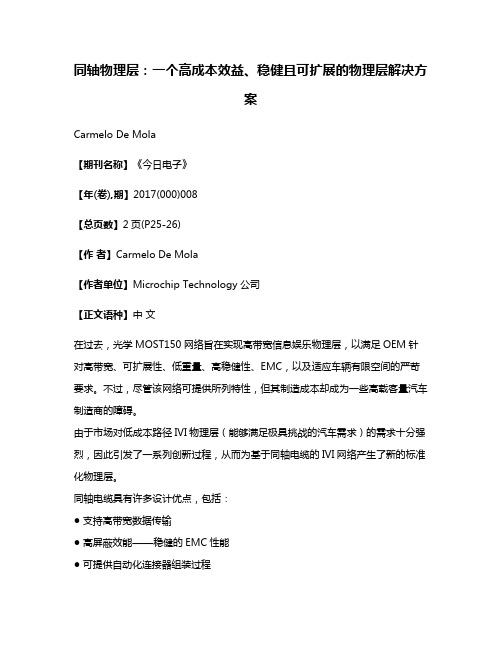
同轴物理层:一个高成本效益、稳健且可扩展的物理层解决方案Carmelo De Mola【期刊名称】《今日电子》【年(卷),期】2017(000)008【总页数】2页(P25-26)【作者】Carmelo De Mola【作者单位】Microchip Technology公司【正文语种】中文在过去,光学MOST150网络旨在实现高带宽信息娱乐物理层,以满足OEM针对高带宽、可扩展性、低重量、高稳健性、EMC,以及适应车辆有限空间的严苛要求。
不过,尽管该网络可提供所列特性,但其制造成本却成为一些高载客量汽车制造商的障碍。
由于市场对低成本路径IVI物理层(能够满足极具挑战的汽车需求)的需求十分强烈,因此引发了一系列创新过程,从而为基于同轴电缆的IVI网络产生了新的标准化物理层。
同轴电缆具有许多设计优点,包括:● 支持高带宽数据传输● 高屏蔽效能——稳健的EMC性能● 可提供自动化连接器组装过程● 满足苛刻的机械要求,如弯曲能力和高温范围● 适合汽车级解决方案的高成本效益● 严格控制的阻抗,支持全双工工作模式● 通过同一电缆实现电力传输和数据发送此外,它们已在汽车行业中使用数十年,可提供成熟可靠的点对点连接,具体应用包括用于天线与无线电之间的连接或者天线与全球移动通信系统(G S M)模块之间的连接。
此外,汽车连接器模型(FAKRA)的标准也可提供,并且已由不同供应商采用。
FAKRA连接器拥有许多不同的形状并且提供不同的颜色和机械编码方案,有助于简化汽车生产线上的装配过程并节省时间。
FAKRA连接器同样能满足苛刻的汽车需求,并且可使用高度自动化的方法进行生产。
图1显示了同轴电缆的横截面。
此模型一目了然地展示了同轴电缆的最大优点,与通过核心导体(1)传输的信号相关联的电场包含在由金属屏蔽(3)限制的空间内。
这样做的结果是,同轴电缆不会向外部辐射能量。
同时,屏蔽(3)可保护核心导体(1)免受外部电场的影响,同时提供较高的信号抗干扰性。
Marvell:TD多载波技术提升终端体验

Marvell:TD多载波技术提升终端体验
鲁义轩
【期刊名称】《通信世界》
【年(卷),期】2011(000)040
【摘要】以存储芯片、移动终端芯片和网络设备芯片为核心产品的Marvell(美满电子),今年在TD终端市场表现活跃,多款基于Marvell芯片的TD智能手机在今年陆续上市.日前,Marvell中国区市场总监吴慧雄在第五届移动互联网国际研讨会上表示,针对明年智能终端市场的更大机遇,Marvell还会继续加大在高端、多核、多载波产品上的投入.
【总页数】1页(P44)
【作者】鲁义轩
【作者单位】
【正文语种】中文
【相关文献】
1.TD技术论坛时光:TD-LTE价值在于终端和体验 [J], 鲁义轩
2.TD网络多指标实现显著提升终端性能提升已获社会渠道认可 [J], 陈琛
3.提升用户体验的TD网络优化技术研究 [J], 赵良毕;于志文;郭同文
4.终端出租体验营销——TD推广利器 [J], 刘见雄
5.TD-SCDMA终端使用体验之联想篇国产先锋打响TD商用冲锋战 [J], 李鹏因版权原因,仅展示原文概要,查看原文内容请购买。
万兆以太网物理层编码芯片设计

万兆以太网物理层编码芯片设计
费瑞霞;朱恩;周忻;赵文虎;王志功
【期刊名称】《数据采集与处理》
【年(卷),期】2004(019)001
【摘要】提出了一种并行处理的编解码方案.采用这种方案,设计了万兆以太网10 G BASE-R标准的物理编码子层发送端芯片.芯片由64 b/66 b编码、扰码和变速箱3部分组成.考虑到测试问题,该芯片内置了伪随机码数据源.这种方案的优点是逻辑简单、速度快.芯片采用TSMC 0.18 μm CMOS工艺,用全定制方式实现.芯片引脚分布时参照PLCC48规格.
【总页数】4页(P95-98)
【作者】费瑞霞;朱恩;周忻;赵文虎;王志功
【作者单位】东南大学射频与光电集成电路研究所,南京,210096;东南大学射频与光电集成电路研究所,南京,210096;东南大学射频与光电集成电路研究所,南
京,210096;东南大学射频与光电集成电路研究所,南京,210096;东南大学射频与光电集成电路研究所,南京,210096
【正文语种】中文
【中图分类】TN722.7
【相关文献】
1.具有90°可调移相的万兆以太网数据判决芯片设计 [J], 程树东;朱恩;孟凡生;孙玲;吴春红;费瑞霞;王志功
2.万兆以太网物理层技术 [J], 苗澎;王志功;李彧
3.万兆以太网交换芯片设计技术 [J], 王锦山
4.万兆以太网物理层转换芯片研究 [J], 郑维山;何书专;李伟
5.万兆以太网物理层编码子层转换芯片研究 [J], 苗澎;王志功
因版权原因,仅展示原文概要,查看原文内容请购买。
基于Vmware的路由器主控单元功能虚拟化
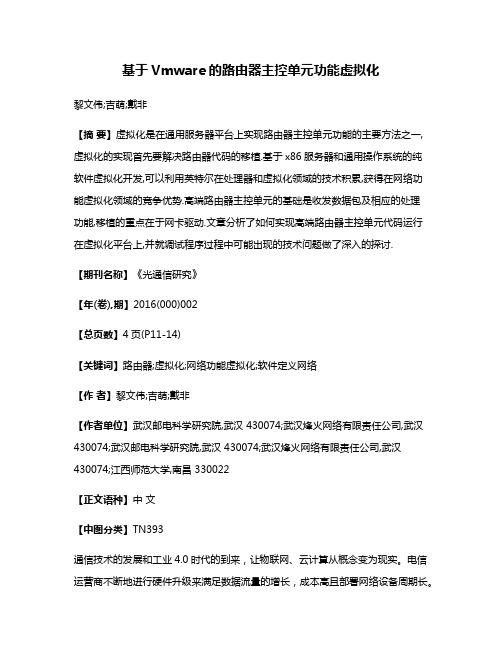
基于Vmware的路由器主控单元功能虚拟化黎文伟;吉萌;戴非【摘要】虚拟化是在通用服务器平台上实现路由器主控单元功能的主要方法之一,虚拟化的实现首先要解决路由器代码的移植.基于x86服务器和通用操作系统的纯软件虚拟化开发,可以利用英特尔在处理器和虚拟化领域的技术积累,获得在网络功能虚拟化领域的竞争优势.高端路由器主控单元的基础是收发数据包及相应的处理功能,移植的重点在于网卡驱动.文章分析了如何实现高端路由器主控单元代码运行在虚拟化平台上,并就调试程序过程中可能出现的技术问题做了深入的探讨.【期刊名称】《光通信研究》【年(卷),期】2016(000)002【总页数】4页(P11-14)【关键词】路由器;虚拟化;网络功能虚拟化;软件定义网络【作者】黎文伟;吉萌;戴非【作者单位】武汉邮电科学研究院,武汉 430074;武汉烽火网络有限责任公司,武汉430074;武汉邮电科学研究院,武汉 430074;武汉烽火网络有限责任公司,武汉430074;江西师范大学,南昌 330022【正文语种】中文【中图分类】TN393通信技术的发展和工业4.0时代的到来,让物联网、云计算从概念变为现实。
电信运营商不断地进行硬件升级来满足数据流量的增长,成本高且部署网络设备周期长。
而NFV(网络功能虚拟化)不仅降低了运营商的硬件采购成本,使组网更灵活,而且与SDN(软件定义网络)、云计算等前沿技术密切相关。
其中基于x86架构的虚拟化技术是实现NFV的重要途径[1]。
虚拟化技术的实现面临的挑战是路由器代码在虚拟环境下的移植。
使用虚拟化技术后,要兼顾处理器高性能和通用性的矛盾,而解决该问题,可以在集成和软件层面做优化。
1.1 技术背景纯软件虚拟化技术出现较早,之后还进一步出现了处理器级虚拟化和I/O(输入/输出)级虚拟化。
纯软件虚拟化的主要问题是效率和隔离性。
为了解决这个问题,市场上出现了OS(操作系统)虚拟化和完全虚拟化方法,但不管何种方法,都因为Hypervisor(虚拟机监视器)的参与而降低了处理器性能。
- 1、下载文档前请自行甄别文档内容的完整性,平台不提供额外的编辑、内容补充、找答案等附加服务。
- 2、"仅部分预览"的文档,不可在线预览部分如存在完整性等问题,可反馈申请退款(可完整预览的文档不适用该条件!)。
- 3、如文档侵犯您的权益,请联系客服反馈,我们会尽快为您处理(人工客服工作时间:9:00-18:30)。
Power efficient Ethernet PHY features for camera and displayAmir Bar-NivGeorge ZimmermanPaul LangnerIEEE Automotive Tech DaySeptember 2019Contributors•Saied Benyamin •Ramin FarjadradThe Path Towards Full AutonomyLevel 1-2Simple Aid2010 -20152015 -20202020 -2025CPU/GPULocal Computing ”Behind” Every SensorCentralized Computing Integrates Input From All Sensors (Sensor Fusion ) Similar to a Human Driver’s BrainHigh-Performance BrainHigh-Speed, Reliable & Secure Nervous System Compute Power (TFLOPS)0.1101100Networking Speed (Gbit/s)0.110125Level 2-3Decision AssistantLevel 4-5Self DrivingCamerasIncreasing resolution from 720p to 4K and improving dynamic rangeMulti-Gigabit/s of raw bandwidth=Sensor Fusion & Rich Data Drive Bandwidth To Multi-GigSensor FusionMoving processing of data from sensors to a centralized GPUMulti-Gigabit/s data over the network=GPUIn-Vehicle-Network (IVN) for ADASEthernet Advantages for Automotive•Standard based. Multiple vendors.•Switching, VLAN: IEEE 802.1•MAC Speeds: 2.5G, 5G, 10G, 25G, 50Gbps (soon 100G)•Security: IEEE-802.1AE MACsec plus Encryption (AES-256)•Synchronization: IEEE-1588v2 PTP (802.1AS and Rev)•Power over Data Line: IEEE PoDL802.3bu (0.5W to 50W)•Audio/Video Bridging: AVB/TSN•Support all topologies: point-to-point, mesh, star, ring, daisy-chain,System backbone GPU GPUGPU System backboneECU ECU ECU ECUGPU GPU ECU GPU GPUSystem backboneMulti-Gig Eth.Sensor backboneEthernet vs. LVDSLVDS EthernetSpeed3G, 6G, 12Gbps 2.5G, 5G, 10G, 25GbpsBit Error Rate (BER)10^-1010^-12Switching (standard based)None IEEE –Dynamic,packet based Synchronization (standard based)None IEEE –1588 PTPPrioritization (standard based)None IEEE–AVB, TSNMAC/PHY Security (standard based)None IEEE –802.1AEBridges to Ethernet Required IEEE –Part of the stackFor camera/sensor interface, the main advantage of LVDS today is that it is asymmetrical, which is lower power then symmetrical mode.Ethernet can leverage the Energy Efficient Ethernet (EEE) mode to ran the PHY in asymmetrical mode, for power saving.IEEE Energy Efficient Ethernet -Overview•Energy Efficient Ethernet (EEE) was introduced in BASE-T PHYs to help computers meet Energy Star power consumptions targets•Basic idea is to turn the link off as much as possible when there is no traffic, and turn it on as quickly as possible when there is traffic (50 us)•State is referred to as Low-power Idle (LPI)•EEE allows:•Up to 90% power savings on a link in LPI state•Full flexibility in BW versus power consumption•The ability to use a standard MAC/PHY interface, as EEE is also standardized onthese interfacesHow EEE Works•EEE is controlled by the Low Power Idle(LPI) client•Allows the MAC & higher layers to go tosleep•Physical layer only knows it is in LPI stateand is quiet most of the time•LPI client signals and controls thetransition in/out of Low Power Idle state•Asymmetric Operation: each directiononly wakes and sends data as neededSource: IEEE Std. 802.3-2018, IEEE Standard for Ethernet, Clause 78, Energy Efficient Ethernet Source: “Energy Efficiency and Regulation” Bruce Nordman, et al. (IEEE 802 tutorial, July 2008)/802_tutorials/2009-07/802 july energy 8.pdfIEEE 802.3az Designed for bursty data –with rapid wake up•Designed for bursty data and requiring minimal buffering •Fast, application-transparent recovery•“The link status shall not change as a result of the transition”Source: “IEEE 802 Tutorial –Energy Efficient Ethernet”, Hugh Barrass, et al. (IEEE 802 tutorial, July 2007)/802_tutorials/07-July/IEEE-tutorial-energy-efficient-ethernet.pdfAdjusting EEE parameters for Asymmetric Links•PHY gets to specify system wake up timing parameters •While Tw_phy is a minimum, Tw_sys_tx can be set longer, to accommodate longer PHY wake up.Source: IEEE Std. 802.3-2018, IEEE Standard for Ethernet, Clause 78, Energy Efficient EthernetAdditional Extensions for EEE in Automotive•A natural extension to the 802.3ch EEE scheme is to introduce a mode to totally shut off transmission when not in use•Referred to as “Link Suspension Mode”•This is specifically designed for I2C control of cameras, where the downstream is continuously transmitting, and the upstream only occasionally (on the order of seconds) transmits a low-speed command •This extension uses the same “Alert signal”, transmitted at specific known times, and a new Idle character to signal total shut-off of the link•It means the camera has to provide the link timing (master) and the far end is phase-locked to it (slave)•The result is that when the GPU wants to send an I2C command, it sends an alert, and then thecamera’s PHY just has to reconverge the filters and potentially timing phase, allowing arelatively quick wake-up•Allows close to 100% total power savings in this modeCompare to Asymmetric PHY approachBlock Diagram of “Tx” PHY (High speed video transmission PHY)Asymmetric EEE OperationImplementation and allowable transition time drives power savingsOn when receive is active On only when both are activeSummaryEthernet allows automotive networking tobuild on existing standards experienceEthernet is Inherently Asymmetric!Savings in packet processing circuitry beyond PHY , minimizes time processor is activeSoCControlVideo1Gbps to >10GbpsComparison of Asymmetrical and Symmetrical PHYs For asymmetrical PHY, the circuits and blocksthat are not required:“Tx” PHY (transmits at high speed):Echo Canceller, ADC (simplified), Equalizer/Decoder(simplified)“Rx” PHY (receives at high speed):Echo Canceller, DAC/Encoder (simplified)Save in size :“Tx” PHY –about 35%“Rx” PHY –about 20% Asymmetrical PHYs:Typical size of 10Gbpssymmetrical PHY is ~2 mm^2Control© 2019 Marvell Confidential, All Rights Reserved.18BACKUPSources for EEE Overviews•“An Overview of Energy Efficient Ethernet” Mike Bennett, youtube talk (TeamNANOG, June 2014)•Includes discussion of fast wake/deep sleep, optics, recent projects•“IEEE 802.3az: The road to energy efficient Ethernet”, Ken Christensen, et. Al, IEEE Communications Magazine, December 2010•“Energy Efficiency and Regulation” Bruce Nordman, et al. (IEEE 802 tutorial, July 2008)•(see slides 27-50) EEE and WiFi energy management•“Baseline Summary”, IEEE 802.3az Task Force Home Page, March 2009• A nice summary of the 802.3az PHY modes•“IEEE 802.3az Energy Efficient Ethernet Task Force Update”, 802.1/802.3 joint meeting Mike Bennett, July 2008•Update on 802.3az approaches, scope related to systems issues•“IEEE 802 Tutorial –Energy Efficient Ethernet”, Hugh Barrass, et al. (IEEE 802 tutorial, July 2007)•Objectives, explanation of 802.3az motivations and approaches• A Brief Tutorial on Power Management in Computer Systems, Dave Chalupsky & Emily Qi (IEEE 802.3 EEE Study Group, March 2007)•Covers both link and Systems level power managementIEEE Energy Efficient Ethernet –802.3ch Modifications •802.3ch copied the EEE mechanism from 2.5G –10GBASE-T PHYs•Allows either direction to go in LPI independent of the other direction •Since 802.3ch implements a hybrid system (which means Tx and Rx are on the same physical copper pairs), it is a strict requirement to keep both ends of the link phase-locked to make the signal processing work•This means a link in the LPI state must periodically transmit a burst of data to keep the far-end receiver phase-locked, and the filters converged•With EEE, a single 802.3ch PHY can be deployed in various system scenarios, effectively supporting all traffic scenarios and scaling the power usage accordingly•Versus fixed, non-standard transmission schemes for each scenario。
